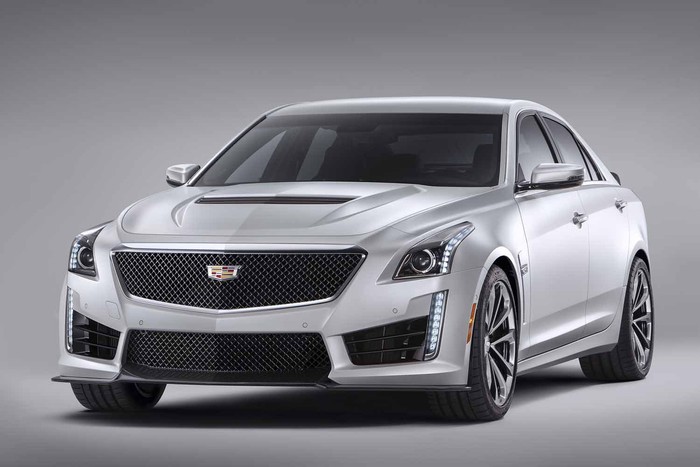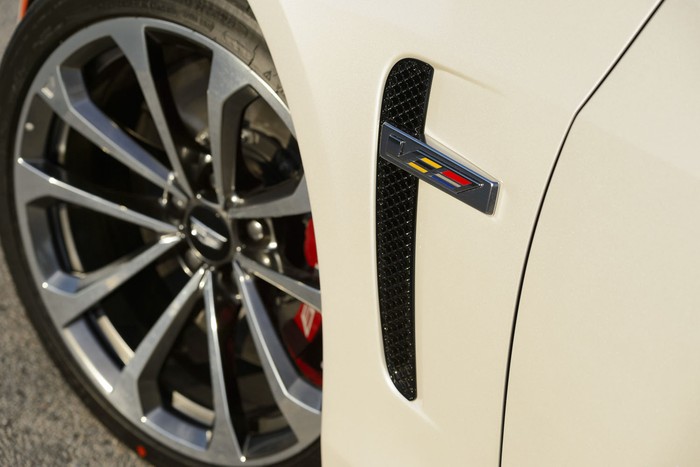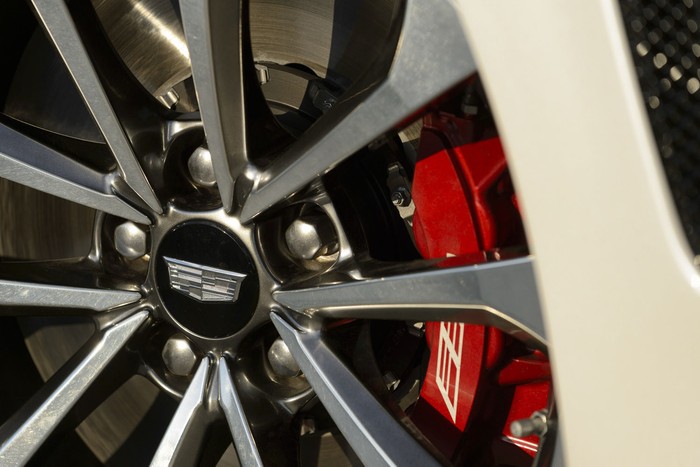

2019 Cadillac CTS-V
The CTS-V shows that heavy, bloated Cadillacs with boat-like handling are a thing of the past. Based on the standard CTS, the V model stands out as the most powerful and one of the most driver-focused cars Cadillac has ever produced in its illustrious history.
Overview
The CTS-V is unabashedly aimed at the BMW M5 and the Mercedes-Benz E63 AMG. On paper, it outguns its main rivals thanks to a supercharged 6.2-liter V8 engine that produces 640 horsepower at 6,400 rpm and 630 lb-ft. of torque at 3,600 rpm. Sourced from the none other than the Chevrolet Corvette Z06, the blown eight-cylinder sends the CTS-V from zero to 60 mph in 3.7 seconds.
Power is transferred to the rear wheels via an eight-speed automatic transmission and an electronic limited-slip differential. The transmission can be left in automatic mode, or it can be shifted manually using steering wheel-mounted shift paddles.
Brembo-designed brakes all around and a sport-tuned version of Cadillac's Magnetic Ride Control suspension system keep the power in check.
Charting the changes
Visually, it's easy to tell the V apart from other members of the CTS family. Notably, it gains a more aggressive-looking front fascia characterized by mesh inserts in the radiator grille, a large air dam, a discreet splitter and a powerdome hood.The track-inspired look continues past the front end with 19-inch forged aluminum wheels tucked under flared fenders. The back end gets four round exhaust pipes, but buyers looking to further stand out can order the CTS-V with a large spoiler and an air diffuser at an extra cost.
Life aboard
The cockpit has been spruced up with 20-way power-adjustable front seats, a leather-upholstered sport steering wheel, carbon fiber trim on the dashboard and on the door panels as well as a model-specific 12.3-inch digital instrument cluster that can be configured to display a wide variety of data.
As with all modern Cadillacs, the ATS-V Coupe is fitted with the controversial CUE infotainment system, which is operated through a touchscreen interface in the center stack along with capacitive-touch controls. Similar to tablet devices, it lets users tap, flick and swipe to control Bluetooth connectivity, entertainment and navigation functions while also providing access to weather information, local fuel prices, Pandora internet radio and more.
However, the system has faced criticism for delayed responses to control inputs, confusing design elements and a lack of conventional buttons for frequently-accessed functions. At least a natural voice recognition system provides an intuitive alternate means of controlling CUE, allowing users to place hands-free calls, enter navigation destinations and select songs without clunky and cumbersome memorized phrases.
Standard and optional equipment
The CTS-V comes generously equipped in order to take on its tech-focused German rivals. The list of standard features includes HID headlights, keyless entry and start, a remote starter, heated front seats, parking sensors on both ends, a 13-speaker Bose sound system, a heads-up display, a wireless phone charger, an electronic parking brake, automatic wipers, dual-zone A/C, Bluetooth connectivity and a panoramic sunroof.
Highlights from the list of options include a carbon fiber hood, Recaro bucket seats, tri-zone A/C and heated rear seats. Buyers can also choose from a handful of option packages. Notably, the Luxury Package bundles tri-zone A/C, a split-folding rear seat, heated rear seats, sun shades out back and a 110-volt power outlet.
Performance Data Recorder
The CTS-V is also available with an optional Performance Data Recorder gleaned from the Chevrolet Corvette Z06 that captures not only a driver's perspective of the road ahead, but also a host of telemetry data for review at a later date. Mounted into the windshield header trim near the rearview mirror, the system's 720p HD camera records everything the driver sees directly in front. Audio is picked up via a dedicated microphone inside the ATS-V's camera, allowing drivers to narrate their own trip if they want.
Additionally, the system records data on an SD card that lets drivers replay their experiences either on the vehicle's instrument cluster (when parked) or on a computer or TV screen at a later date.
Four modes include three data overlay screens, which look something like a video game display:
Track mode - includes speed, RPM, g-force, lap times and even a location-based map discerned from the car's GPS and Bing-enabled satellite maps.
Sport mode - a more limited display with speed and g-force.
Performance mode - designed to show performance metrics like 0-60 mph runs, 1/4 mile sprints and 0-100 mph runs.
Touring mode - A simple video and audio-only replay.
Using Track mode, drivers can view corner traces, cornering force and vehicle speed to analyze their driving habits
Occupant safety
In addition to traction and stability control systems, the CTS-V offers front, thorax, pelvic, side curtain, knee, and rear thorax airbags. A lane departure warning system, a rear-view camera, rear cross-traffic alert and lane-keeping assist also come standard.
Key competitors
As mentioned above, the Cadillac CTS-V is aimed squarely at the BMW M5 and the Mercedes-AMG E63.



























- Propulsion: Gas 6.2L V8
- Power: 640hp
@
6400rpm - Torque: 630ft⋅lb
@
3600rpm - Mileage: TBD MPG ( 14 city, 21 hwy)
- Transmission: 8-speed Automated Manual
- Seating: 5 seats
in
2 rows - Passenger Volume: 97.0cu ft
- Length: 197.6in
- Wheelbase: 114.6in
- Height: 57.2in
- Weight: 4141lbs
- Cargo Volume: 13.7cu ft
- Front Leg Room: 45.7in
- Front Head Room: 40.4in
- Front Hip Room: 53.8in
- Rear Leg Room: 35.4in
- Rear Head Room: 37.5in
- Rear Hip Room: 53.3in
- Drag Coefficient: 52.7/47.3
- Drag Coefficient: TBD